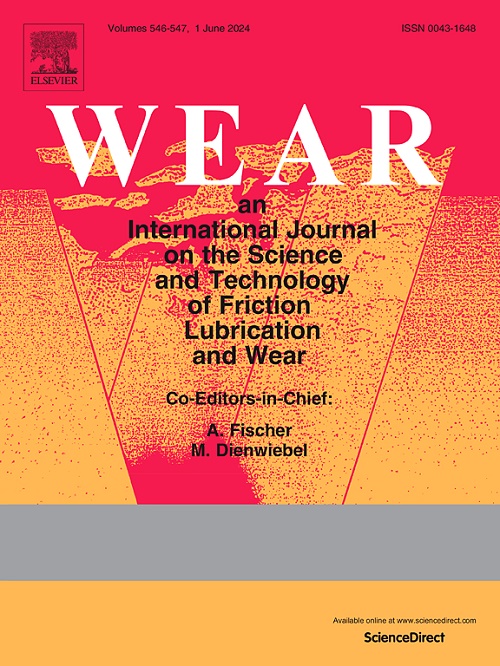Wear properties of cemented carbides with new binder solutions for rock drilling inserts
IF 5.3
1区 工程技术
Q1 ENGINEERING, MECHANICAL
引用次数: 0
Abstract
Cemented carbides with tungsten carbide grains as hard phase and metallic cobalt binder phase are used extensively for drill bit inserts for rock drilling. The process of rock drilling is severe with some of the wear happening through fracture in the cemented carbide. This work investigated two cemented carbides with iron rich alternative binder phases containing different amounts of FCC phase, intended to minimise the fractures through formation of a BCC phase. The samples are tested next to a reference with cobalt binder and investigations of the as-sintered samples show only very small differences in many of the relevant properties and microstructural features, including hardness, toughness, grain size distribution and binder phase volume fraction. The main difference found is in the amount of FCC in the binder phase microstructure. In a rock turning test it is found that both alternative binder drill bit inserts perform better than the reference with cobalt binder phase, studies of the wear scars show that the wear progresses though fracture of material in all samples with no discernible differences seen. There is however a correlation between volume fraction of FCC in iron-based binders and reduced wear, showing that the concept is promising for further studies.
新型钻头黏结剂对硬质合金磨损性能的影响
以碳化钨晶粒为硬相和金属钴结合相的硬质合金广泛用于凿岩钻头镶齿。岩石钻削过程是剧烈的,部分磨损是通过硬质合金的断裂发生的。本研究研究了两种含不同FCC相的富铁结合剂相的硬质合金,旨在通过形成BCC相来减少裂缝。样品在钴结合剂的参考下进行测试,对烧结样品的研究表明,在硬度、韧性、晶粒尺寸分布和结合剂相体积分数等许多相关性能和微观结构特征上只有非常小的差异。发现的主要区别在于粘结剂相微观结构中FCC的数量。在岩石切削试验中,发现两种替代粘结剂钻头的性能都优于钴粘结剂钻头,对磨损痕的研究表明,在所有样品中,磨损都是通过材料断裂进行的,没有明显的差异。然而,FCC在铁基粘合剂中的体积分数与减少磨损之间存在相关性,表明该概念有进一步研究的前景。
本文章由计算机程序翻译,如有差异,请以英文原文为准。
求助全文
约1分钟内获得全文
求助全文
来源期刊

Wear
工程技术-材料科学:综合
CiteScore
8.80
自引率
8.00%
发文量
280
审稿时长
47 days
期刊介绍:
Wear journal is dedicated to the advancement of basic and applied knowledge concerning the nature of wear of materials. Broadly, topics of interest range from development of fundamental understanding of the mechanisms of wear to innovative solutions to practical engineering problems. Authors of experimental studies are expected to comment on the repeatability of the data, and whenever possible, conduct multiple measurements under similar testing conditions. Further, Wear embraces the highest standards of professional ethics, and the detection of matching content, either in written or graphical form, from other publications by the current authors or by others, may result in rejection.
 求助内容:
求助内容: 应助结果提醒方式:
应助结果提醒方式:


